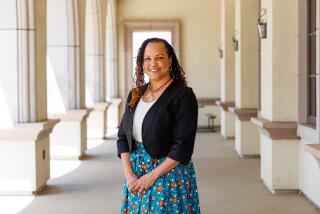MISSION VIEJO : Classroom Assistance a Good Sign
- Share via
When Mary Ann Saporito’s Saddleback College speech class recently broke into groups of two, her group had a third person: Chris Gonzales, her interpreter.
While the other students, most of whom speak English as their second language, talked noisily around her, Saporito watched intently as Gonzales’ fingers translated Tomoko Matsumoto’s words into sign language.
For Saporito and other hearing-impaired students, studying and going to class regularly are not enough to ensure scholastic success. Sign-language interpreters like Gonzales are an important link to learning for them.
“It is impossible to pass a class or go to college with a hearing impairment of my degree and learn because you do not hear what’s going on,” said Saporito, 47.
A mother of five who hopes to pursue a career working with deaf children or teen-agers, Saporito began to notice a loss in her own hearing about 15 years ago. Two of her children have Usher syndrome, which has left them deaf and suffering from tunnel vision. It is not uncommon for Usher parents to lose their hearing, Saporito said.
Although she can hear her teachers or read their lips as long as they speak slowly and enunciate directly in front of her, Saporito is lost without an interpreter when teachers move about the class, turn their backs to write on the chalkboard or invite class discussion.
Students who have been deaf since birth are even more reliant on interpreters than Saporito, said Trish Fipps, a counselor with the state Department of Rehabilitation.
“If you do not have a qualified interpreter, it makes it extremely difficult for the student,” Fipps said. Sometimes clients who have failed classes complain that the interpreter did not provide all the information or did not show up, Fipps said.
Federal law requires Saddleback and other schools that receive federal funding to allow deaf students to take whatever classes they want and to provide interpreters if needed.
Saporito said Saddleback has generally been supportive, but she recently filed a complaint against the school with the office of civil rights, an agency within the U.S. Department of Education. She said that the school has not provided interpreters for summer school and that school officials told her the week before this semester started that an interpreter was only available for one of her four classes.
Saporito now has interpreters for all of her classes, and school officials have said that interpreters will be provided for summer classes.
Pat Griffin, the head of special services at Saddleback, said the college lined Saporito up with a full slate of interpreters within a day after classes started.
Constance Carroll, president of Saddleback, said the school has always provided the necessary services for its 600 to 700 disabled students, three of whom are hearing impaired.
“We really do bend over backwards to make those (interpreter) matches,” Carroll said. “I don’t know why this particular student has complained.”
Saporito said the college has a low pay scale for interpreters, which makes it difficult to attract interpreters who are experienced with the sometimes technical language used in classes.
Saddleback pays its interpreters $7 to $10 an hour, but is in the process of evaluating its pay scale, Griffin said. In comparison, hourly pay for interpreters statewide ranges from $7.50 to $20, said Bob Cummings, assistant director of the Dayle McIntosh Center for the Disabled. The nonprofit center provides services to disabled people to help them live independently.
More to Read
Sign up for Essential California
The most important California stories and recommendations in your inbox every morning.
You may occasionally receive promotional content from the Los Angeles Times.










